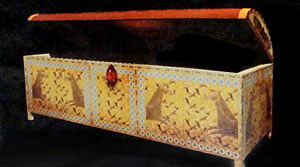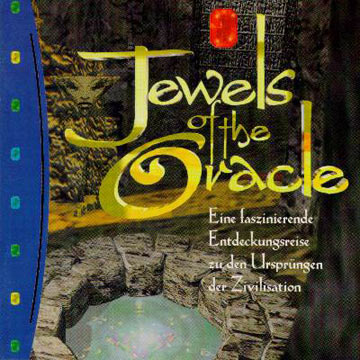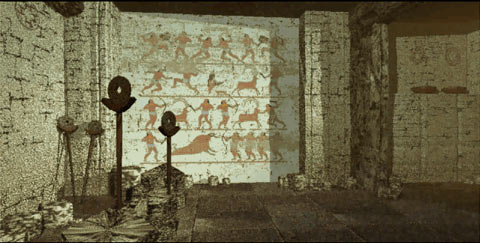
I named our production company after the race of humans in the distant future who dwelled on the surface from The Time Machine by H.G. Wells - hence the vortex at the centre of the "O" - but what I didn't realize was that the Morlocks (the race of monstrous creatures who lived underground) would be the publishers. They declared bankruptcy before Jewels made any serious money worldwide - a lot of people made money from the game - unfortunately, I was not one of them.

Here's a helicopter POV of the ancient city I invented for the game. The six large buidlings at the centre were called "the houses of the poets" and each represented a social strata of urban responsibility. I had spent years studying archaeology and ancient cultures at University - so some of that rubbed off and ended up in the game. All the names of the houses and the 24 puzzles were in Sanskrit.
The world of the city was supposed to be from somewhere between 5,000 and 7,000 BC and would have been the very first agrarian city state. Unfortunately, all evidence had been lost until the discovery that begins the game. The ending of the game took the player into the well and out into the central hexagon in the middle of the city - the soundtrack let you hear the people of the market from 10,000 years ago, but it's a bit sad, because it's all gone. To be honest, I don't think too many people finished. I never did get much feedback about the ending.
.

Here's the Oracle in the middle of rising up out of the well and reciting verse - it was supposed to be a visual reward for completing each of the six wedges of the well interface (4 puzzle devices). His lines were written in iambic pentameter, but people complained he was too difficult to understand. I just thought they were missing the point he was an Oracle - you're not supposed to understand him - whatever he says is open to interpretation. I abandoned the idea in the sequel.

The Horse chest was placed in a stable and was one of the first puzzles developed for the prototype - that helped sell the game. It was also one of our first solutions to what we called the "puzzle reveal." We couldn't enter or leave a puzzle that was partially solved. These days, with the capturing and rendering capabilities, you can do stuff like that. In the early '90s you had to invent a way to start a puzzle program launch every time.
Russell Lowke was the Lead Programmer on the game. He went on to Harvard University to take a degree in the field of Information Technology and Software Engineering. He is currently contracting for Disney Interactive Media Group (among others) and has his own website Lowke Media where you can look at his recent work and even play some of the Jewels puzzles.
He has posted the *.dcr files in his "Archive" section, but you can play some of them on line using Adobe Flash Player in his "Projects" section. As he says on his site, he has been "slowly rewriting them (from scratch) using Flash 7 (AS2), the most accessible Internet environment possible."
You can click on the links here to play individual puzzles. Once you enter the puzzle program, there's a menu button, help button, and reset button at the top of the screen.
Leap of the Locust
Hall of the Nightsky
Values of Al-Jabara
Abhoranam of Day and Night
Turning of the Divasah
Sowing Seeds
Nice work Russell!

Here's a German package that combines elements of my original box with some other elements of their own. The game was availble on the Sega Saturn, the Sony Playstation and PC CD-ROM in 37 countries and I don't know how many languages. I personally oversaw the French, German and Kanji, but after that...I don't know. We lost control of the project when the publisher declared bankruptcy. Ownership got transferred to other distributors who had no contract with ELOI Productions. You can still buy Jewels, Gems and Jewels II on amazon.com (but not amazon.ca)

This is one of my favourite and most difficult sequence puzzles in the game. A little "dung beetle" can be seen at the top left. He pushes the little balls into the exit hole at the bottom centre. The dung beetle idea is taken from the Eyptian notion of a scarab beetle pushing the Sun across the sky. That's why the game was in the chest in the Sun room. The player could click on one of the four levers at the bottom or just use the cursor arrow keys on the keyboard.

Some of the rooms had wall paintings depicting stories or cultural events. This one had an "easter egg" animation - if you looked into the eye of one of those vertical staves. This old style of game was also known as "hot spot hunting," because the player was continually searching for the right place to click. Today, you can walk around and look around anywhere in a virtual 3D environment. That was absolutely unheard of 20 years ago when we were making Jewels.

The brilliant maze was designed by my brother Matt. The maze covers the surfaces of a 6-sided cube. You move your piece (the little orange one) with your mouse in order to travel around the surfaces of the cube - it rotates - until you arrive at the solution & goal of the path (the little turquoise dot).

This one is based on a traditional school of entertainment, but with an archaeological twist. The player has to match pairs of items based on shared elements. What was fun was incorporating ancient items such as the "quern" - in the bottom right - which is an ancient grinding bowl - and other early, anicent tools.
< PREVIOUS | NEXT >
